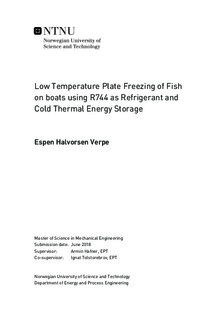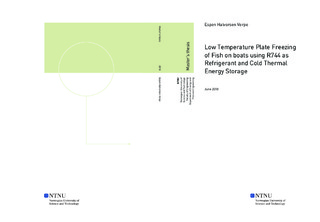| dc.description.abstract | The introduction of low temperature R744 freezing systems enables lower evaporating temperatures and faster freezing times, however, also a lower system efficiency (COP). This thesis will investigate how low temperature CO2 compares to traditional refrigerants in plate freezers, regarding energy efficiency and product capacity, where the latter is of special importance for fishing vessels.
A numerical freezing model was made to simulate freezing of fish blocks in plate freezers, and was validated with experiments on industrial plate freezer, by freezing of a phase changing test material. COP was estimated for the freezing system, and selected natural refrigerants was modeled. The freezing model relied on a two-dimensional, heat capacity-temperature, implicit finite difference method with time dependent temperature boundary conditions. The evaporating temperature is not static, as one might expect, but dynamic due to varying heat load from the product side. The reason being the compressor cannot deliver the required freezing capacity for peak loads. The elevation of the evaporating temperature results in prolonged freezing times and reduced product capacity, compared to ideal freezing with constant plate temperature. The conditions in the low pressure receiver was modeled to estimate the temperature increase, which was also validated. A thermal storage with CO2 as phase change material was investigated, with objective to eliminate the elevated temperature in the beginning of the freezing process by storing energy when compressor capacity is larger than heat load, and release that energy when the compressor struggles to maintain the low evaporating pressure. Ice formation/melting in the storage tank was modeled to determine the dimensioning size.
The numerical freezing model demonstrated good agreement with experiments, with a deviation in freezing time of only 3 %. Numerical calculations revealed that low temperature freezing, down to -50 Celsius, require 71 % and 57 % more energy per kilo fish than for -30 Celsius and -40 Celsius, respectively, assuming R744 COP and 100 mm thick blocks. The higher energy consumption is mainly due to decreased COP for lower evaporation temperatures, which was estimated to be 1.75, 2.25 and 2.98 for the abovementioned temperatures, using R744. In addition, product capacity (kg frozen fish per hour) is increased by correspondingly 66 % and 34 % by lowering the evaporating temperature to -50 Celsius. When implementing a energy storage system, shorter freezing times were obtained, because the pressure in the low pressure receiver is not elevated as much in the beginning of the freezing process. Results suggest a product capacity increase of 2.92 % for a low temperature R744 freezer with thermal energy storage solution. The tank volume was determined to be between 614 and 422 liters, and required between 1377 and 702 tubes, of 1 meter length and 10 mm radius. | |

